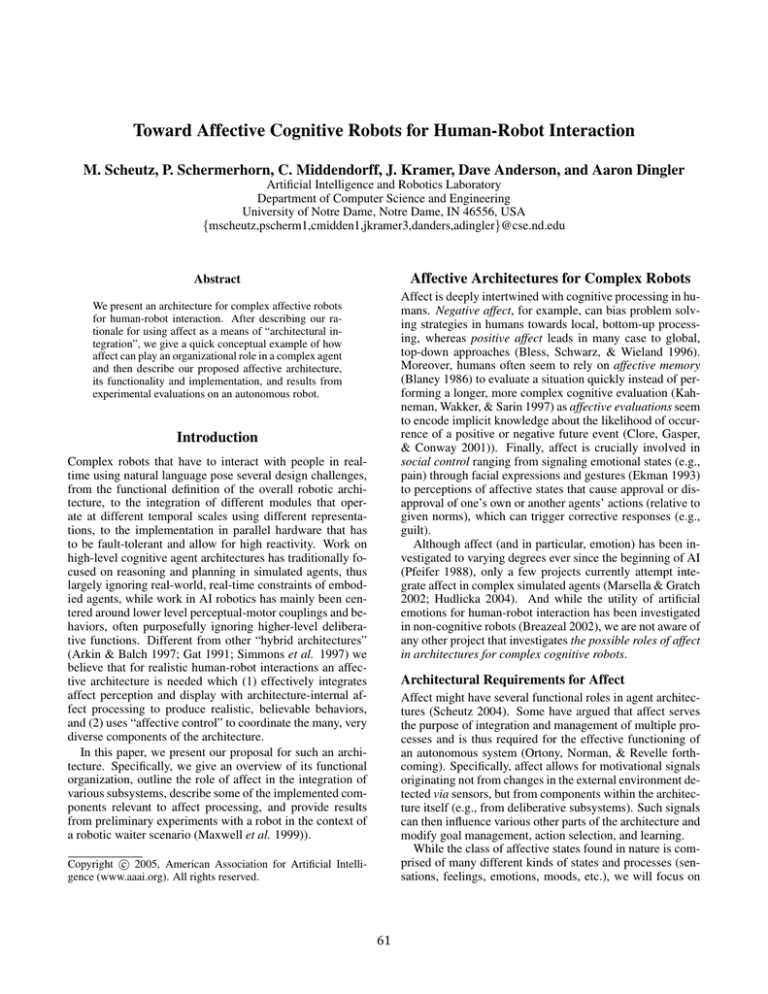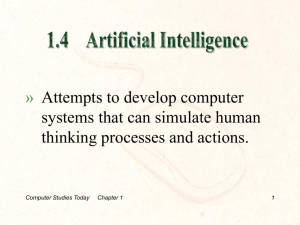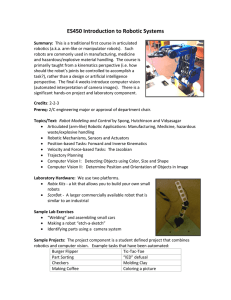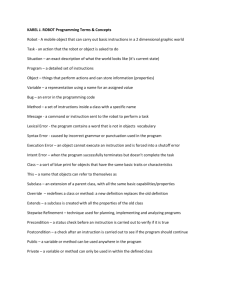
Toward Affective Cognitive Robots for Human-Robot Interaction
M. Scheutz, P. Schermerhorn, C. Middendorff, J. Kramer, Dave Anderson, and Aaron Dingler
Artificial Intelligence and Robotics Laboratory
Department of Computer Science and Engineering
University of Notre Dame, Notre Dame, IN 46556, USA
{mscheutz,pscherm1,cmidden1,jkramer3,danders,adingler}@cse.nd.edu
Affective Architectures for Complex Robots
Abstract
Affect is deeply intertwined with cognitive processing in humans. Negative affect, for example, can bias problem solving strategies in humans towards local, bottom-up processing, whereas positive affect leads in many case to global,
top-down approaches (Bless, Schwarz, & Wieland 1996).
Moreover, humans often seem to rely on affective memory
(Blaney 1986) to evaluate a situation quickly instead of performing a longer, more complex cognitive evaluation (Kahneman, Wakker, & Sarin 1997) as affective evaluations seem
to encode implicit knowledge about the likelihood of occurrence of a positive or negative future event (Clore, Gasper,
& Conway 2001)). Finally, affect is crucially involved in
social control ranging from signaling emotional states (e.g.,
pain) through facial expressions and gestures (Ekman 1993)
to perceptions of affective states that cause approval or disapproval of one’s own or another agents’ actions (relative to
given norms), which can trigger corrective responses (e.g.,
guilt).
Although affect (and in particular, emotion) has been investigated to varying degrees ever since the beginning of AI
(Pfeifer 1988), only a few projects currently attempt integrate affect in complex simulated agents (Marsella & Gratch
2002; Hudlicka 2004). And while the utility of artificial
emotions for human-robot interaction has been investigated
in non-cognitive robots (Breazeal 2002), we are not aware of
any other project that investigates the possible roles of affect
in architectures for complex cognitive robots.
We present an architecture for complex affective robots
for human-robot interaction. After describing our rationale for using affect as a means of “architectural integration”, we give a quick conceptual example of how
affect can play an organizational role in a complex agent
and then describe our proposed affective architecture,
its functionality and implementation, and results from
experimental evaluations on an autonomous robot.
Introduction
Complex robots that have to interact with people in realtime using natural language pose several design challenges,
from the functional definition of the overall robotic architecture, to the integration of different modules that operate at different temporal scales using different representations, to the implementation in parallel hardware that has
to be fault-tolerant and allow for high reactivity. Work on
high-level cognitive agent architectures has traditionally focused on reasoning and planning in simulated agents, thus
largely ignoring real-world, real-time constraints of embodied agents, while work in AI robotics has mainly been centered around lower level perceptual-motor couplings and behaviors, often purposefully ignoring higher-level deliberative functions. Different from other “hybrid architectures”
(Arkin & Balch 1997; Gat 1991; Simmons et al. 1997) we
believe that for realistic human-robot interactions an affective architecture is needed which (1) effectively integrates
affect perception and display with architecture-internal affect processing to produce realistic, believable behaviors,
and (2) uses “affective control” to coordinate the many, very
diverse components of the architecture.
In this paper, we present our proposal for such an architecture. Specifically, we give an overview of its functional
organization, outline the role of affect in the integration of
various subsystems, describe some of the implemented components relevant to affect processing, and provide results
from preliminary experiments with a robot in the context of
a robotic waiter scenario (Maxwell et al. 1999)).
Architectural Requirements for Affect
Affect might have several functional roles in agent architectures (Scheutz 2004). Some have argued that affect serves
the purpose of integration and management of multiple processes and is thus required for the effective functioning of
an autonomous system (Ortony, Norman, & Revelle forthcoming). Specifically, affect allows for motivational signals
originating not from changes in the external environment detected via sensors, but from components within the architecture itself (e.g., from deliberative subsystems). Such signals
can then influence various other parts of the architecture and
modify goal management, action selection, and learning.
While the class of affective states found in nature is comprised of many different kinds of states and processes (sensations, feelings, emotions, moods, etc.), we will focus on
c 2005, American Association for Artificial IntelliCopyright gence (www.aaai.org). All rights reserved.
61
complex motivational and emotional states (such as “desiring to win a grant” or “worrying about whether the proposal can be completed in time”), which can be caused by
a combination of perceptions and processes internal to the
agent (e.g., results of complex deliberations about the utility of trying to achieve a particular goal compared to alternatives). Complex emotions, for example, may include
any of the following, based on (Beaudoin & Sloman 1993;
Ortony, Clore, & Collins 1988) and others:
1. an elicitor (e.g., the grant proposal)
2. an eliciting condition (e.g., the possibility of (1) not being
completed by the deadline)
3. criteria for the evaluation of (2) based on various factors
such as beliefs, goals, norms, standards, tastes, attitudes,
etc. (e.g., completing (1) by the deadline is crucial to
research career)
4. an evaluation of (2) in terms of (3) (e.g., (2) is undesirable)
5. possible causes for (2) (e.g., deadline approaching
rapidly, work progressing too slowly, etc.)
6. a hedonic attitude towards (2) (e.g., displeasure)
7. a measure of the urgency to act on (1) given (2) (e.g., urgent)
8. a set of strategies to cope with (2) (e.g., cancel meetings,
focus attention on (1), etc.)
9. a set of motivations to be instantiated based on (8) (e.g.,
being able to continue one’s research, being able to fund
students, etc.)
10. a set of emotions to be instantiated based on (4) through
(8) (e.g., distress)
11. the selected motivation (if any) based on (4) through (8)
(e.g., being able to continue research)
Consequently, complex representational and processing
mechanisms (e.g., pattern matching and rule instantiation)
are required for architectures to be able to represent possible
or impossible, likely or unlikely future or hypothetical states
and thus support complex motivations and emotions.
We have defined an architecture that allows for the representation and instantiation of complex motivational and
emotional states in an effort to study the utility of these states
in architecture internal processes (in addition to being able
to detect affect in others and to express it).
note the functional role of the component in the overall system. The colored/grayish components are part of the affect
system, which is used to control the robot’s actions and drive
the behavior of the robot over time by providing internal
feedback about the success or failure of an action.
We will now illustrate the architecture-internal roles of
affect (i.e., motivations and emotions) in a concrete example taken from a (fictitious) robotic waiter scenario in a bar,
which specifically demonstrates the roles of joy, pride, gratitude, and relief as they interact with goal management, memory, and social control.
Example: An Envisioned Interaction between a
Patron and a Robotic Waiter
Suppose the bartender was late fixing the drink ordered by
patron X. The waiter W has noticed that (by examining the
urgency slot in the representation of its goal to serve X’s
drink) and instantiated a fear state about the possibility of
being yelled at by an angry X. Among W’s current goals
are to keep patrons happy, to deliver the drink to X, and to
scold the bartender for being late with the drink preparation.
This goal is caused by the fear state and might result in a
“shift blame” strategy, if yelled at by X. W has a positive
attitude towards happy people in general, and consequently
a positive attitude towards X. W’s affect evaluation system
uses this as a norm to thank people when they make compliments. W also has an extended notion of “self” that includes the bartender (e.g., as a result of their both being part
of the same institution). Currently, W is located next to the
X (after having picked up the drink from the bartender, although without having had a chance to scold him), and has
just said, “Here’s your Manhattan, Sir, sorry for the delay.”
X has taken the drink, sipped it, smiled, and said, “No problem, you guys make the best Manhattans!”
Tracing this scenario through the architecture, where colored/dashed links indicate the information flow connected
to various affective states (red=relief, green=gratitude, purple=pride, dark blue=joy at having achieved the goal of delivering the drink, light blue = joy at having achieved the
goal of making the patron happy): W’s attention is focused
on X, whose face becomes the focal point of the scene. The
completion of the deliver drink goal elicits joy. W sees X
smile and hears the tone of his exclamation, from which it
concludes that X is pleased. This elicits a joy reaction, due
to facilitating the keep patrons happy goal. It is also taken
as evidence that X is not angry, which reduces W’s level of
fear. W recognizes X’s exclamation as a compliment, which
elicits relief due to the conclusion that X is not angry and has
the added effect of canceling the scold bartender goal. Further, pride is elicited as a combination of facilitating the keep
patrons happy goal and being part of the compliment’s object. W obsesses further about the attribution of the compliment, determines that the bartender is responsible, and generates a congratulate bartender goal, while committing this
event to episodic memory (because of its affective salience).
Finally, due to the thank people norm, W is motivated to say,
“Thank you very much, sir. I’ll tell the bartender you said
so”. The whole event will be stored in W’s episodic memory for subsequent analysis. In particular, W will be able to
A Partial Affective Architecture
Figure 1 depicts a partial view of the functional organization
of the proposed affective architecture for complex robots.1
Columns separate sensors, perceptual, central, and action
processing components, and effectors. All boxes depict autonomous computing components that can operate in parallel and communicate via several types of communication
links (in the figure, only links that are part of affective processing pathways are shown).2 Labels of components de1 This
diagram of the architecture is restricted to visual and auditory sensors and camera motors and speaker as effectors; other
sensors such as sonar and laser sensors, or effectors, such as grippers and wheel motors, are not shown. Moreover, several internal
components related to navigation and complex action sequencing
(e.g., spatial maps, sequencers, etc.) are not depicted either.
2 The implementation builds on the ADE system available at
http://ade.sourcefore.net/.
62
Sensors
Camera
framegr.
Perceptual Processing
Object
detect.
Central Processing
Action Processing
Object
recogn.
Scene
parsing
Scene
analysis
Action
select.
Reflexes
Visual
STM
Visual
Attent.
Visual
LTM
Skills
Camera
control
Object
Tracking
Affect
expr.
Face
recogn.
Affect
recogn.
Affect.
apprais.
Second.
apprais.
Episodic
memory
Goal
manager
Problem
Solver
Affect
LTM
Task
Manager
Effectors
Camera
motors
Joy (patron happy goal)
Pride
Gratitude
Relief
Microphones
Sound
detect.
Affect.
apprais.
Declar.
LTM
Concept.
LTM
Task
LTM
Sound
recogn.
Motive
gener.
Object
STM
Task
STM
Voice
recogn.
Dictionary
Semantic
analysis
Sentence
prod.
Reflexes
Auditory
STM
Word
recogn.
Sentence
parsing
Text-tospeech
Sound
control
Affect
recogn.
Auditory
Attent.
Auditory
LTM
Joy (delivery goal)
Speakers
Affect
expr.
Figure 1: A partial view of the proposed affect architecture for a complex robot. Boxes depict concurrently running components of varying
complexity and colored/grayish components indicate affective control mechanisms. The five different arrow types depicted indicated the
information flow through the architecture involved in processing five different affective processes.
learn that it is good to wait for the outcome of an action A
(like deliver drink) before shifting blame to agents causing
a delay in A (e.g., scolding the bartender right away), since
the result of A might not cause W to be blamed for A being
delayed. “Learning” here could mean reducing the strength
of the connection between the fear state, which instantiates
anger, and ultimately blame, and the urgency parameter of
the goal blame cause of anger.
the advantages and disadvantages of various architectural
mechanisms (e.g., affective control) in given situations. For
example, one could set up a scenario, where patrons with
different levels of frustration make too many requests within
a short period of time for the robot to be able to satisfy
them all and examine the utility of using affective evaluations of the patrons and prioritization of goals based on affective states to determine the best order in which to satisfy
the patrons’ requests such that their overall levels of frustrations as measured by special purpose devices (Riseberg et
al. 1998) will be minimized. We believe that this kind of
evaluation will be critical for future robotic systems in order
to determine not only their utility, but also the appropriateness and safety in human-robot interactions (both of which
will become more and more critical issues as AI technology
matures and robots become part of society).
Unfortunately, such quantitative evaluations are not yet
possible with current robotic systems, which are still too
brittle in their performance (given the low reliability of visual and auditory perceptual processing in noisy environments, the computational limitations on autonomous systems, the burden of real-time processing of multiple information channels, etc.). Hence, we have to restrict ourselves
to a quantitative evaluation, which nevertheless can verify
some of the critical features of the system. In particular, it
can demonstrate that (1) the system is capable of successful interaction with people in real-world environments using
natural language, (2) it is capable of expressing and using
affect as part of the task performance, and (3) it can accomplish the waiter task in a variety of initial conditions.
Evaluation of the Current System
While being able to achieve a natural interaction as described in the ficticious scenario is still a long-term goal and
will unlikely be feasible in the near future in any robotic
system, it is possible to test the proposed architecture in a
variety of limited versions of the above scenario. However,
it is important to point out that a comprehensive quantitative
evaluation of such a robotic system, even though highly desirable in principle, can be very difficult to achieve in practice.3 Ideally, we would like a highly controlled set of initial
conditions, under which the robot has to perform a given
task. Based on a set of performance criteria and by carefully
manipulating various dimensions (ranging from task, to architectural, to environmental parameters), we could then
empirically determine a “performance space”, which reflects
3 Even in the case of human waiters general quantitative, agreed-
upon criteria for performance evaluation might not exist, even
though qualitatively it seems easy to distinguish good from bad
waiters based on efficiency in serving, polite behavior with patrons,
personality, etc.
63
Next we will describe the architecture implementation,
the experimental setup, the action interpreter, and results
from experiments in a simplified waiter task.
salient objects in the environment, as well as path planning
and high-level navigation.
The architecture is implemented on a fully autonomous
Pioneer Peoplebot from ActivMedia (with sonar, pan-tiltzoom camera, a SICK laser range finder, three sonar rings,
two microphones, two speakers, one built-in Linux PC104
board, and two added Dell laptops, one running Linux, the
other running Windows XP, connected through a local Ethernet network, with wireless access to the outside world).
Implementation and Experimental Setup
The implementation of the proposed architecture is–almost
by necessity–work in progress given the intrinsic complexity
of the system.4 However, several subsystems are functional
and their interactions allow the robot to integrate sensory
information from sonar, laser, bumper, vision, and auditory
sensors, process information at several levels in parallel, and
perform several actions: from finding and tracking multiple
people in a room, to following trajectories in a room, to producing emotional speech output. For space reasons, we can
only briefly touch on some subsystems.
The vision subsystem, for example, provides information about detected faces using and histogram methods from
(Yang, Kriegman, & Ahuja 2002) as well as skin color, color
of clothes, and camera angle relative to the robot, which
are used in conjunction with information about the distance
of an object (coming from sonar and laser sensors) to find
and track people in a room (Scheutz, McRaven, & Cserey
2004) and determine some of their salient features such as
height (Byers et al. 2003) for future identification. The emotion recognition component currently only classifies faces as
“happy”, “sad” or “neutral”.5
The natural language processing subsystem integrates
and extends various existing components (CMU’s SPHINX
and IBM’s ViaVoice for spoken word recognition, an enhanced version of “thought treasure” (Mueller 1998) for natural language understanding and production, and a modified
version of the University of Edinburgh’s Festival system for
speech synthesis). Novel components are employed for affect recognition in voices and an affect expression in spoken
language to recognize and express the four emotional states
“angry”, “frightened”, “happy”, and “sad”.6
The action control subsystem is based on a novel action
interpreter, which interprets scripts for natural language understanding augmented by action primitives for the control
of actions (see following Subsection). These scripts can be
combined in hierarchical and recursive ways, yielding complex behaviors from basic behavioral primitives, which are
grounded in basic skills (the bottom layer control structures
are implemented as motor schemas as in (Arkin & Balch
1997)). Moreover, several spatial maps are used for the
representation of locations of the robot, people, and other
Action Processing in the Waiter Task
Figure 2 depicts snapshots from a typical run with the robot
in the waiter task. Here the robot first has to find people
in the reception area (A) (this is achieved using camera and
range finder information). Once a person has been detected,
the robot approaches the person and starts a conversation (B)
(the figure shows the face and eye-brow tracking for emotion detection), the length of which depends on the robot’s
“happiness”, which, in turn, is affected by the conversation
topic and the degree to which the robot is able to find an appropriate semantic representation of the human’s utterance.
Eventually, the robot asks if the person would like a drink
(C), takes the order (if it knows that the drink is available),
and moves to the bar area (D), which is stored in an internal
map. It detects the bar tender and asks him to get the requested drink (E) (the figure shows the bartender putting the
drink on the robot’s tray), after which it returns to the person asking the person to take the drink (F). Successful timely
task completion leads to a change in the robot’s “happiness”,
which is then reflected in its voice output and propensity to
converse more with people. All motions are controlled by
the action interpreter based on scripts stored in long-term
memory:
====serve-drink//serve.V
role01-of=waiter|
role02-of=human|
role03-of=beverage|
role04-of=bar|
timeout-of=600sec|
event01-of=[wander waiter]|
event02-of=[shiftFOA waiter human]|
event03-of=[converse waiter human]|
event04-of=[say-to waiter human [fetch-from waiter bar beverage]]|
event05-of=[move-to waiter bar]|
event06-of=[say-to waiter bar [active-goal waiter
[fetch-from waiter bar beverage]]]|
event07-of=[move-to waiter human]|
event08-of=[shiftFOA waiter human]|
event09-of=[say-to waiter human [active-goal-weaker waiter
[fetch-from human waiter beverage]]]|
“Roles” indicate entities and “events” denote of descriptions
of actions and state-of-affairs involving these entities. In
the above script all events denote actions (MOVE - TO, SHIFTFOA for “shift focus of attention”, and SAY- TO) are action
primitives, while “wander” and “converse” refer to other
scripts, leading to a recursive structure of scripts).
A primitive action like MOVE - TO(hwaiteri, hlocationi)
then has a particular meaning to the robotic system. In this
case, the action interpreter passes the action on to the navigation system (after having substituted “self” for hwaiteri),
which interprets it as a command to move the robot to the
coordinates (x, y) of hlocationi (represented in a discrete,
topological map). The high-level navigation system translates the action into commands for the low-level navigation
4 Most components are implemented in some rudimentary form,
even though the majority of the components does not yet update in
parallel.
5 Emotion detection in uncontrolled environments is very difficult and turned out to be too inexact to pick up on subtle emotional
expressions and changes. The current system is too unreliable to
be of practical use. We recently learned, however, that Jeff Cohen
and Takeo Kanade with their groups at CMU have been making
progress in tracking action units in faces, which could lead to much
more reliable emotion detection and tracking.
6 A separate paper on the details of these subsystems, which employ a combination of signal processing and neural-network methods, is in preparation.
64
Figure 2: Snapshots (A) through (F) (top left to bottom right) from the robot’s performance of a waiter task (see text for details).
system, which eventually causes the robot to move in a particular direction, if possible (e.g., it will not move there if
obstacles block the location, although it will attempt to move
around obstacles that obstruct the path to the final location).
Note that the same script can also be used for “understanding” actions of others without having to carry them out,
because the “serve-drink script” is not defined in an indexical way (i.e., assuming that the robot is the waiter), but rather
defined generically so that the action interpreter can use the
present context to determine who should assume the waiter
role. If based on the context an entity other than the robot
should be the waiter, then this will only lead to a new binding
of the symbol “waiter” in the present context in the robot’s
working memory, whereas a binding of “waiter” to “self”
will cause the robot to perform an action.
In addition to action primitives or references to other
scripts, scripts can also contain descriptions for failure recovery actions, which the action interpreter can use to detect failures in action sequencing. For example, suppose the
robot was about to the deliver a drink, but the patron has already left. In that case, the SERVE - DRINK - TOhpatroni goal
cannot be met, hence the script SERVE - DRINK fails, and the
recovery action might be to bring the drink back to the bar.
As a result, the emotional state of “self” can be adjusted,
which consequently allows for an additional context-based
adjustment of goals, preferences, attitudes, and ultimately
behavior. Again note that the emotional adjustments prescribed as part of the scripts are also essential for understanding the internal makeup of other agents (e.g., if the
robot needs to understand what it was like for another waiter
to serve a drink in vain). To allow for such adjustments of
internal states, scripts can include conditional branching on
evaluations of internal states (e.g., emotional states) of any
entity, including self (to the extent that they are accessible).
For example, observing the waiter failing at a task and knowing that failure causes anger or sadness (depending on the
prior state of the agent), it is possible to infer that the waiter
must be angry or sad. The action interpreter can also perform actions on such representations of internal states (e.g.,
modify parameters of complex emotions).7
Performance
Currently, the most critical performance bottleneck is the
natural language processing system, given that all experimental runs in the waiter task have essentially the same outcome: if the robot is able to process the human request correctly (i.e., to properly recognize spoken words, parse the
sentence, and build an appropriate semantic representation,
which happens in about 1 out 5 runs), then it will successfully complete the task (i.e., process the request, move to the
bar without collisions, get the desired drink, and return with
7 The current implementation of the action interpreter is still
somewhat impoverished, as variables for other scripts have not
been implemented yet. E.g., it is not possible to add “variable actions” to scripts such “pick any script that satisfies preconditions Xi
and execute it”, which would cause the action interpreter to search
through its scripts and match them against the preconditions Xi .
Also, the current implementation only supports detection of failures, but not “recursive” attempts to recover from them (“recursive” as recovery actions might themselves fail and might thus lead
to recovery from recovery, etc.).
65
it to the patron).8
Clore, G.; Gasper, K.; and Conway, H. 2001. Affect as
information. In Forgas, J., ed., Handbook of affect and
social cognition. Mahwah, NJ: Erlbaum. 121–144.
Ekman, P. 1993. Facial expression and emotion. American
Psychologist 48(4):384–392.
Gat, E. 1991. Integrating planning and reacting in a heterogeneous asynchronous architecture for mobile robots.
SIGART Bulletin 2 70–74.
Hudlicka, E. 2004. Beyond cognition: Modeling emotion
in cognitive architectures. In Proceedings of 6th International Conference on Cognitive Modeling, 118–123.
Kahneman, D.; Wakker, P.; and Sarin, R. 1997. Back to
bentham? explorations of experienced utility. Quarterly
Journal of Economics 112:375–405.
Marsella, S., and Gratch, J. 2002. Modeling the influence of emotion on belief for virtual training simulations. In Proceedings of the 11th Conference on ComputerGenerated Forces and Behavior Representation.
Maxwell, B. A.; Meeden, L. A.; Addo, N.; Brown, L.;
Dickson, P.; Ng, J.; Olshfski, S.; Silk, E.; and Wales, J.
1999. Alfred: The robot waiter who remembers you. In
Proceedings of AAAI Workshop on Robotics.
Mueller, E. T. 1998. Natural language processing with
ThoughtTreasure. New York: Signiform.
Ortony, A.; Clore, G.; and Collins, A. 1988. The Cognitive Structure of the Emotions. New York: Cambridge
University Press.
Ortony, A.; Norman, D.; and Revelle, W. forthcoming. Effective functioning: A three level model of affect, motivation, cognition, and behavior. In Fellous, J., and Arbib, M.,
eds., Who needs emotions? The Brain Meets the Machine.
New York: Oxford University Press.
Pfeifer, R. 1988. Artificial intelligence models of emotion.
In Hamilton, V.; Bower, G. H.; and Frijda, N. H., eds., Cognitive Perspectives on Emotion and Motivation, volume 44
of Series D: Behavioural and Social Sciences. Netherlands:
Kluwer Academic Publishers. 287–320.
Riseberg, J.; Klein, J.; Fernandez, R.; and Picard, R. 1998.
Frustrating the user on purpose: Using biosignals in a pilot
study to detect the user’s emotional state. In Conference on
Human Factors in Computing Systems CHI ’98, 227–228.
Scheutz, M.; McRaven, J.; and Cserey, G. 2004. Fast,
reliable, adaptive, bimodal people tracking for indoor environments. In IEEE/RSJ International Conference on Intelligent Robots and Systems (IROS).
Scheutz, M. 2004. Useful roles of emotions in artificial
agents: A case study from artifici al life. In Proceedings of
AAAI 2004.
Simmons, R.; Goodwin, R.; Haigh, K.; Koenig, S.; and
Sullivan, J. 1997. A layered architecture for office delivery
robots. In First International Conference on Autonomous
Agents, 235 – 242.
Yang, M.-H.; Kriegman, D. J.; and Ahuja, N. 2002. Detecting faces in images: A survey. IEEE Transactions on
Pattern Analysis and Machine Intelligence 24(1):34–58.
Conclusion
We have presented an architecture for complex affective
robots, where affective signals serve several functional roles
in the overall architecture in addition to improving user interaction. A large part of the architecture has been implemented on an autonomous robot and its intended behavior has been verified over several preliminary experimental
evaluations in the waiter task.
Future work on the implementation of the architecture will focus on (1) improving the language subsystem–
currently the main performance bottleneck–by employing
more robust voice recognition and statistical parsing components, and (2) the action interpreter by allowing for different forms of learning via special “learning scripts” that
can monitor actions, record failures and successes, and use
the internal affective states of the robot to adjust parameters
in existing scripts (such as the numeric parameters in emotional representations) or to create new scripts based on the
successful completion of tasks for which no single script exists (cp. to “chunking” in SOAR). This will eventually allow
more rigorious evaluations based on systematic experiments
varying architectural parameters that can assess the utility of
affective control processes in a quantitative way.
Over the next few months, we expect the robotic implementation of the architecture to mature to a point where it
will be ready for demonstrations of the waiter task outside
our lab (in particular, we plan to demonstrate it at the upcoming 2005 AAAI robot competition).
References
Arkin, R. C., and Balch, T. R. 1997. AuRA: principles and
practice in review. JETAI 9(2-3):175–189.
Beaudoin, L., and Sloman, A. 1993. A study of motive processing and attention. In Sloman, A.; Hogg, D.;
Humphreys, G.; Partridge, D.; and Ramsay, A., eds.,
Prospects for Artificial Intelligence. Amsterdam: IOS
Press. 229–238.
Blaney, P. H. 1986. Affect and memory: A review. Psychological Bulletin 99(2):229–246.
Bless, H.; Schwarz, N.; and Wieland, R. 1996. Mood
and the impact of category membership and individuating information. European Journal of Social Psychology
26:935–959.
Breazeal, C. L. 2002. Designing Sociable Robots. MIT
Press.
Byers, Z.; Dixon, M.; Goodier, K.; Grimm, C. M.; and
Smart, W. D. 2003. An autonomous robot photographer.
In Proceedings of IROS 2003.
8 All other subfunctions such as finding people and approaching
them, detecting their faces, producing natural language sentences
with emotional expression, prioritizing goals based on affective
value, avoiding obstacles, navigating through the environment, etc.
work properly given enough time (e.g., a face might not be recognized right away, or getting around an obstacle on the way to the
bar will take time.
66




